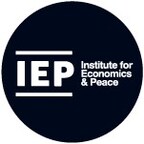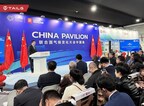Fintech PR
Water investment key to averting global conflict surge

LONDON, Oct. 30, 2024 /PRNewswire/ — Today marks the launch of the 5th edition of the Ecological Threat Report (ETR) from international think-tank, the Institute for Economics & Peace (IEP). The report concludes that without concerted international action, accelerating ecological degradation will amplify social friction and conflicts worldwide. These challenges will be further exacerbated by climate change.
Key results:
- Ecological risks are intensifying due to climate change, population growth, and conflict, with a strong correlation between ecological degradation, poverty and the incidence of conflict.
- 50 countries, currently home to 1.3 billion people, face high or very high levels of ecological threat. The population in these nations is projected to increase to almost 2 billion by 2050.
- The ETR identifies 27 ecological hotspots countries: where extreme ecological risks intersect with low societal resilience, leaving them vulnerable to instability, conflict and humanitarian crisis.
- Of the 27 hotspot countries, 19 are in sub-Saharan Africa and four are in the Middle East and North Africa. Many are currently experiencing conflict or civil unrest.
- Conflict prevention in agro-pastoralist communities is strongly linked to the strength of local governance structures, with community-based approaches proving more successful than external interventions.
- Sub-Saharan Africa has the lowest irrigation rates in the world, with only 1.8 per cent of cultivated land being irrigated. There is substantial opportunity to relieve ecological pressure through improved water collection and management.
- An annual investment of $15 billion in water capture and agricultural enhancement initiatives to 2050 could lift food production in sub-Saharan Africa by 50%.
The 2024 Ecological Threat Report covers 207 countries and highlights a growing global crisis as ecological threats, climate change, poor governance, population growth and conflict intersect. The report identifies 50 countries, home to 1.3 billion people, facing high or very high levels of ecological threats. These countries, 82% of which are in Africa, are projected to see a 51% population increase by 2050.
Sub-Saharan Africa emerges as a particular area of concern. A recent severe El Niño-induced drought in the region has affected 68 million people, or 17% of the region’s population. The drought, which started in early 2024, has hit crop and livestock production, causing food shortages and damaging wider economies. Food prices are 25% higher than before the COVID-19 pandemic, further compounding access to food.
However, the region has the greatest potential globally to improve its food production capacity. For example, the average maize yield in Africa is just 1.9 tonnes per hectare, compared to the global average of 5.4 tonnes. Additionally, the region possesses 200 million hectares of untapped arable land. By implementing micro-water capture techniques and adopting improved agricultural practices, sub-Saharan Africa could substantially enhance its ecological resilience and food security.
Steve Killelea, Founder & Executive Chairman of IEP, said: “The world is at a critical juncture where ecological threats are increasingly intertwined with conflict risks, poverty and debt. Our research shows that targeted investments in water capture and agricultural practices could dramatically improve food security, increase local resilience, lessen conflict and alleviate forced migration.“
Ecological Hotspots
The ETR identifies 27 ecological hotspots: countries where high ecological risks intersect with low societal resilience. These hotspot countries face increased risks of instability, conflict, and humanitarian crises. The geographical distribution of these hotspots is heavily skewed, with 19 located in sub-Saharan Africa, four in the Middle East and North Africa, and the remaining four spread across Asia and the Caribbean.
- Sub-Saharan Africa faces the most acute ecological threats, driven by high levels of food insecurity, water stress, and rapid population growth.
- South Asia recorded the second-highest overall ETR score, driven by its vulnerability to natural disasters, which are the highest of any region.
- Europe and North America are the only two regions where no subnational areas face high or very high levels of ecological threat.
Hotspot countries tend to cluster geographically, which can lead to regional instability as ecological and humanitarian crises will encompass multiple countries. Spillover effects include population displacement, new cross-border conflicts, and disruptions to transportation networks and supply chains.
The severity of the situation is underscored by the fact that many hotspot countries are currently experiencing armed conflicts or civil unrest, highlighting the interplay between ecological threats, low resilience, and heightened risk of violence. Without addressing these challenges, the compounding effects of population growth, environmental degradation, and weak governance could lead to a cycle of increasing instability, particularly in regions already prone to conflict.
Governance & Water Management
Water risk is more closely tied to weak governance than water scarcity. For example, the UAE faces low water risk despite limited resources, while nearby Yemen struggles despite having more abundant water resources. The report highlights that an annual investment of $15 billion in small-scale water capture and related initiatives could substantially mitigate ecological risks in sub-Saharan Africa, with the potential to triple crop yields in some areas. This is crucial, as the region needs to more than double its cereal production to meet its basic food needs over the next 25 years.
The ETR also identifies potential solutions, particularly in water management and agricultural practices, that could significantly improve food security and economic prospects in vulnerable regions. Small-scale water capture projects like sand dams, rock runoff and dams in Africa show promising results, with a single $50,000 investment potentially irrigating up to 9 hectares and yielding a $180,000 return. Sub-Saharan Africa has approximately 34.2 million hectares of land with untapped irrigation potential, which could be utilised using less than 6% of the region’s renewable water resources.
Steve Killelea added: “It’s crucial that governments and international organisations prioritise these interventions to build resilience and prevent future conflicts. Strengthening local governance and community-based conflict resolution mechanisms has proven more effective than external security interventions in mitigating tensions before they escalate into violence.“
Climate change acts as a threat amplifier, exacerbating existing tensions in areas with a history of conflict, weak institutions, and low resilience. In areas prone to resource competition, climate-induced scarcity of water or arable land can escalate tensions between communities. The impact is particularly pronounced in countries with weak institutions, where governments lack the capacity to effectively manage climate-related stresses or mediate resulting conflicts.
The rise of agro-pastoralist conflicts in the Sahel affects over 50 million people, demonstrating how ecological pressures can intensify existing ethnic and resource-based tensions. Transnational extremist groups have exploited these local grievances to mobilise fighters and escalate conflicts. The Sahel region accounts for nearly 16% of Africa’s total conflict deaths, despite comprising only 6.8% of the continent’s population. Of particular concern is the encroachment of these groups into areas that were relatively peaceful, including the West African countries of Côte d’Ivoire, Benin, Togo and Nigeria.
Water and food security
Water risk is strongly correlated with weak governance and poor infrastructure, with sub-Saharan Africa using only 2% of its renewable water resources for agriculture, compared to an average across all global regions of 6.7%. However, with appropriate investment the worst effects can be avoided. Only 1.8% of cultivated land in sub-Saharan Africa is irrigated, less than one-tenth of the global rate of 19%.
Additionally, advances in irrigation technology will make water use in agriculture more efficient, with irrigated land in low- and middle-income countries expected to increase by 34% by 2030, but total agricultural water usage expected to increase by only 14%.
Future global implications
Climate change is set to stress water resources in the glacier-fed ecosystems of South Asia and South America, while rising sea levels will increase salinity in some of the world’s most fertile agricultural regions, particularly in Southeast Asia. More extreme weather in China and India will make it harder to feed the 2.8 billion people who live there. Additionally, more than 91 million people depend on the lower Mekong River Basin and Nile deltas for their livelihoods, with upstream damming severely affecting water flows.
The global implications of these ecological threats extend beyond regional boundaries. Food shortage in one area can impact global food prices and availability due to the interconnected nature of supply chains. As climate change intensifies, there will be significant shifts in global migration patterns, reshaping demographics and economies in both origin and destination countries. Adequate investment in more efficient water and land use for agriculture can dramatically mitigate the worst effects of ecological degradation, improve economies, prevent conflict, and reduce forced migration.
NOTES TO EDITORS
For more information and to download the Ecological Threat Report 2024, visit https://visionofhumanity.org and https://economicsandpeace.org. Video footage for broadcast and sound for radio is available by contacting Tim Johnston below.
About the Institute for Economics & Peace (IEP): IEP is an international and independent think tank dedicated to shifting the world’s focus to peace as a positive, achievable, and tangible measure of human wellbeing and progress. It has offices in Sydney, Brussels, New York, The Hague, Mexico City and Nairobi.
Logo – https://mma.prnewswire.com/media/2538078/IEP_Logo.jpg
![]() View original content:https://www.prnewswire.co.uk/news-releases/water-investment-key-to-averting-global-conflict-surge-302285929.html
View original content:https://www.prnewswire.co.uk/news-releases/water-investment-key-to-averting-global-conflict-surge-302285929.html

Fintech PR
Redefining Financial Frontiers: Nucleus Software Celebrates 30 Years with Synapse 2024 in Singapore

SINGAPORE, Nov. 23, 2024 /PRNewswire/ — The thriving India–Singapore partnership in banking and technology reached a new milestone as Nucleus Software celebrated 30 years of transformative innovation at Synapse 2024, held in Singapore. The event underscored the company’s role in redefining financial services across Southeast Asia (SEA) and the globe, bringing together leaders in finance and technology to explore a shared vision for the future of banking.
Synapse 2024 celebrated 30 years of Nucleus Software’s leadership in driving transformative change across Singapore and Southeast Asia’s financial ecosystem. The event also shone a spotlight on the Global Finance & Technology Network (GFTN), an initiative supported by the Monetary Authority of Singapore (MAS) to champion responsible technology adoption. The event highlighted the deepening synergies between India and Singapore, driven by their shared commitment to innovation, cross-border collaboration, and financial inclusion. As the financial services sector undergoes rapid evolution with advancements in artificial intelligence, blockchain, and digital banking, these partnerships are setting the stage for a more connected, resilient, and inclusive global ecosystem.
Vishnu R. Dusad, Co-founder and Managing Director of Nucleus Software, reflected on the milestone: “For over 30 years, we’ve had the privilege of aligning our journey with Singapore’s ascent as a global financial powerhouse. Back in 1994, when we chose to go East instead of West, it was a bold and emotional decision—guided by our belief in Singapore as a hub for innovation and collaboration. We saw then what remains true today: Singapore is at the heart of the global financial landscape, a place where new ideas take root, and partnerships thrive.”
The event brought together a distinguished array of participants, highlighting the transformative potential of India–Singapore collaboration. Mr. Piyush Gupta, CEO of DBS Group and the Guest of Honor, set the tone for the event with his opening remarks, emphasizing the transformative role of big tech in reimagining scalable, customer-centric financial services in the digital age.
Following his address, key speakers enriched the discussions with their insights. Mr. Sopnendu Mohanty, Chief Fintech Officer at the Monetary Authority of Singapore and Group CEO-Designate of The Global Finance & Technology Network (GFTN), underlined the importance of fostering responsible technology adoption and building inclusive financial ecosystems. Mr. Vinod Rai, globally respected public policy expert, Distinguished Visiting Research Fellow at the National University of Singapore, and former Comptroller and Auditor General of India, shared his perspectives on governance and policy frameworks in financial systems. Mr. S.M. Acharya, Chairman of Nucleus Software and former Defence Secretary of India, offered a visionary outlook on leveraging technology to modernize and secure banking frameworks. Finally, Mr. Pieter Franken, Co-founder and Director of GFTN (Japan), a global FinTech pioneer and deep tech innovator, discussed the future of decentralized finance and its implications for the financial sector.
The event showcased the transformative role of technology in global financial systems, emphasizing innovations that set benchmarks for scalability and inclusivity. Panelists discussed the importance of localized solutions, the challenges of cross-border integration, and leveraging dual business models to optimize capital and foster public participation. The dialogue highlighted the need for common standards, unified frameworks like APIs, and collaborative efforts to accelerate financial inclusion and drive global connectivity in the digital age.
For 30 years, Nucleus Software has consistently introduced advanced lending and banking solutions that support financial institutions’ evolving needs in Singapore and South East Asia. Driven by lean development methodologies like Acceptance Test-Driven Development (ATDD) and Continuous Integration/Continuous Delivery (CICD), Nucleus Software continues to push boundaries in efficient, flexible, and secure financial technology.
Photo: https://mma.prnewswire.com/media/2565374/Synapse_2024.jpg
Logo: https://mma.prnewswire.com/media/2565373/Nucleus_Software_Logo.jpg
![]() View original content to download multimedia:https://www.prnewswire.co.uk/news-releases/redefining-financial-frontiers-nucleus-software-celebrates-30-years-with-synapse-2024-in-singapore-302314485.html
View original content to download multimedia:https://www.prnewswire.co.uk/news-releases/redefining-financial-frontiers-nucleus-software-celebrates-30-years-with-synapse-2024-in-singapore-302314485.html

Fintech PR
ROYAL CANADIAN MINT REPORTS PROFITS AND PERFORMANCE FOR Q3 2024
OTTAWA, ON, Nov. 22, 2024 /PRNewswire/ — The Royal Canadian Mint (the “Mint”) announces its financial results for the third quarter of 2024 that provide insight into its activities, the markets influencing its businesses and its expectations for the next 12 months.
“As the markets continue to change, the Mint is proving its ability to seize on new opportunities thanks to its diversified structure and flexible business strategy” said Marie Lemay, President and CEO of the Royal Canadian Mint.
The financial results should be read in conjunction with the Mint’s annual report available at www.mint.ca . All monetary amounts are expressed in Canadian dollars, unless otherwise indicated.
Financial and Operational Highlights
- The financial results for the third quarter of 2024 were ahead of target and higher than 2023 levels. Higher gold market pricing and foreign circulation volumes combined with lower fixed costs were the main drivers for the quarter over quarter increase. These increases were partially offset by lower than expected bullion volumes from the continued soft demand in the global bullion market. The Mint expects to meet its financial goals for 2024, as set out in its 2024-2028 Corporate Plan, the Mint’s Leadership team continues to actively monitor its status.
- Consolidated revenue decreased to $252.7 million in 2024 (2023 – $360.6 million).
Revenue from the Precious Metals business decreased to $217.6 million in 2024
(2023 – $328.4 million):- Gold bullion volumes decreased 38% quarter over quarter to 106.1 thousand ounces (2023 – 170.1 thousand ounces) while silver bullion volumes decreased 20% to 2.7 million ounces (2023 – 3.4 million ounces).
- Gold and silver market prices increased quarter over quarter by 27% and 23%, respectively.
- Sales of numismatic products decreased 12% quarter over quarter mainly due to the high demand in 2023 for the Queen Elizabeth II’s Reign products.
- Revenue from the Circulation business increased to $35.1 million in 2024
(2023 – $32.2 million):- Revenue from the Foreign Circulation business increased 77% quarter over quarter, a reflection of higher volumes produced and shipped in 2024 as compared to 2023.
- Revenue from Canadian coin circulation products and services decreased 12% quarter over quarter as fewer coins were required to replenish inventories, combined with lower program fees in accordance with the memorandum of understanding with the Department of Finance.
- Overall, operating expenses decreased 27% quarter over quarter to $28.3 million (2023 – $36.0 million) mainly due to planned reductions in consulting and workforce expenses.
Consolidated results and financial performance
(in millions)
|
13 weeks ended |
39 weeks ended |
|||||||||||
|
Change |
Change |
|||||||||||
|
September |
September |
$ |
% |
September |
September 30, 2023 |
$ |
% |
|||||
|
Revenue |
$ |
252.7 |
$ 360.6 |
(107.9) |
(30) |
$ 861.2 |
$ 1,841.8 |
(980.6) |
(53) |
|||
|
Profit (loss) for the period |
$ |
5.7 |
$ (5.8) |
11.5 |
(198) |
$ 24.1 |
$ 15.0 |
9.1 |
61 |
|||
|
Profit (loss) before |
$ |
1.4 |
$ (8.7) |
10.1 |
(116) |
$ 12.3 |
$ 23.4 |
(11.1) |
(47) |
|||
|
Profit (loss) before |
0.6 % |
(2.4) % |
1.4 % |
1.3 % |
||||||||
|
(1) Profit (loss) before income tax and other items is a non-GAAP financial measure. A reconciliation from profit for the period to profit before income tax and other items is included on page 13 of the Mint’s 2024 Third Quarter Report. |
|
(2) Profit (loss) before income tax and other items margin is a non-GAAP financial measure and its calculation is based on profit before income tax and other items. |
|
As at |
||||||||||
|
September 28, 2024 |
December 31, 2023 |
$ Change |
% Change |
|||||||
|
Cash |
$ |
58.4 |
$ |
59.8 |
(1.4) |
(2) |
||||
|
Inventories |
$ |
71.5 |
$ |
68.8 |
2.7 |
4 |
||||
|
Capital assets |
$ |
174.2 |
$ |
173.0 |
1.2 |
1 |
||||
|
Total assets |
$ |
376.8 |
$ |
380.4 |
(3.6) |
(1) |
||||
|
Working capital |
$ |
99.2 |
$ |
97.8 |
1.4 |
1 |
||||
As part of its enterprise risk management program, the Mint continues to actively monitor its global supply chain and logistics networks in support of its continued operations. Despite its best efforts, the Mint expects changes in the macro-economic environment and other external events around the globe to continue to impact its performance in 2024. The Mint continues to mitigate potential risks as they arise through its enterprise risk management process.
To read more of the Mint’s Third Quarter Report for 2024, please visit www.mint.ca.
About the Royal Canadian Mint
The Royal Canadian Mint is the Crown corporation responsible for the minting and distribution of Canada’s circulation coins. The Mint is one of the largest and most versatile mints in the world, producing award-winning collector coins, market-leading bullion products, as well as Canada’s prestigious military and civilian honours. As an established London and COMEX Good Delivery refiner, the Mint also offers a full spectrum of best-in-class gold and silver refining services. As an organization that strives to take better care of the environment, to cultivate safe and inclusive workplaces and to make a positive impact on the communities where it operates, the Mint integrates environmental, social and governance practices in every aspect of its operations.
For more information on the Mint, its products and services, visit www.mint.ca. Follow the Mint on LinkedIn, Facebook and Instagram.
FORWARD LOOKING STATEMENTS AND NON-GAAP FINANCIAL MEASURES
This Earnings Release contains non-GAAP financial measures that are clearly denoted where presented. Non-GAAP financial measures are not standardized under International Financial Reporting Standards (IFRS) and might not be comparable to similar financial measures disclosed by other corporations reporting under IFRS.
This Earnings Release contains forward-looking statements that reflect management’s expectations regarding the Mint’s objectives, plans, strategies, future growth, results of operations, performance, and business prospects and opportunities. Forward-looking statements are typically identified by words or phrases such as “plans”, “anticipates”, “expects”, “believes”, “estimates”, “intends”, and other similar expressions. These forward-looking statements are not facts, but only estimates regarding expected growth, results of operations, performance, business prospects and opportunities (assumptions). While management considers these assumptions to be reasonable based on available information, they may prove to be incorrect. These estimates of future results are subject to a number of risks, uncertainties and other factors that could cause actual results to differ materially from what the Mint expects. These risks, uncertainties and other factors include, but are not limited to, those risks and uncertainties set forth in the Risks to Performance section of the Management Discussion and Analysis in the Mint’s 2023 annual report, as well as in Note 9 – Financial Instruments and Financial Risk Management to the Mint’s Audited Consolidated Financial Statements for the year ended December 31, 2023. The forward-looking statements included in this Earnings Release are made only as of November 20, 2024 and the Mint does not undertake to publicly update these statements to reflect new information, future events or changes in circumstances or for any other reason after this date.
For more information, please contact: Alex Reeves, Senior Manager, Public Affairs, Tel: (613) 884-6370, [email protected]
View original content:https://www.prnewswire.co.uk/news-releases/royal-canadian-mint-reports-profits-and-performance-for-q3-2024-302314428.html

Fintech PR
OIVE and ViniPortugal celebrate closing of joint campaign that reached 100 million consumers
MADRID and PORTO, Portugal, Nov. 22, 2024 /PRNewswire/ — For three years, A Shared Passion showed European consumers the quality and unparalleled versatility of Iberian wines. The program reached over 100 million consumers with advertising in airports, train stations, press trips, digital content, and other actions with opinion leaders.
The wine interprofessionals of Spain (OIVE) and Portugal (ViniPortugal) celebrated the closing of their ambitious joint campaign A Shared Passion with flagship events in Madrid and Porto. The closing event in Spain took place in Madrid’s iconic Calle Alcalá, while in Portugal, the World of Wine (WOW) in Porto was the perfect setting to present the achievements of the international collaboration. Both ceremonies were very well received by the press and the wine sector, highlighting the impact of the promotional actions that reached more than 79.2 million travelers in key transport infrastructures.
The campaign included 22 study trips, taking 150 specialized journalists to explore the world of wine in both countries and generating publications that reached nearly 15 million European consumers.
On social media, the A Shared Passion profile on Instagram exceeded 15,000 followers, consolidating its presence in the digital sphere. In addition, exclusive activities such as workshops and VIP dinners contributed significantly to this initiative’s global impact.
The final events were honored by the presence of opinion leaders, such as Masters of Wine Pedro Ballesteros and Dirceu Vianna Júnior, who moderated round tables with the presidents of OIVE, Fernando Ezquerro, and ViniPortugal, Frederico Falcão. The conference concluded with masterclasses that highlighted Spain and Portugal’s extraordinary oenological diversity, reinforcing the relevance of the sector in the economic, social, and environmental sustainability of both countries.
With funding from the European Union, A Shared Passion highlighted not only the quality and authenticity of Iberian wines but also their strategic role in the sustainable development of numerous municipalities. This initiative underlines the passion with which Spanish and Portuguese wines are made, reflecting their rich traditions and commitment to the future.
For more information: www.asharedpassion.com
Video: https://mma.prnewswire.com/media/2565600/ViniPortugal_and_OIVE.mp4
![]() View original content to download multimedia:https://www.prnewswire.co.uk/news-releases/oive-and-viniportugal-celebrate-closing-of-joint-campaign-that-reached-100-million-consumers-302314339.html
View original content to download multimedia:https://www.prnewswire.co.uk/news-releases/oive-and-viniportugal-celebrate-closing-of-joint-campaign-that-reached-100-million-consumers-302314339.html

-

 Fintech3 days ago
Fintech3 days agoFintech Pulse: Industry Updates, Innovations, and Strategic Moves
-

 Fintech2 days ago
Fintech2 days agoFintech Pulse: Daily Industry Brief – A Dive into Today’s Emerging Trends and Innovations
-

 Fintech PR3 days ago
Fintech PR3 days agoROLLER Releases 2025 Attractions Industry Benchmark Report, Unveiling Key Trends and Revenue Strategies
-

 Fintech PR3 days ago
Fintech PR3 days agoTAILG Represents the Industry at COP29, Advancing South-South Cooperation with Low-Carbon Solutions
-

 Fintech5 days ago
Fintech5 days agoFintech Pulse: Navigating Expansion, Innovation, and Sustainability
-

 Fintech4 days ago
Fintech4 days agoFintech Pulse: Milestones, Partnerships, and Transformations in Fintech
-

 Fintech PR2 days ago
Fintech PR2 days agoCritical Metals Surge Opens Prime Opportunity for Mining Investors
-

 Fintech PR3 days ago
Fintech PR3 days agoThe CfC St. Moritz Announces New Speakers from BlackRock, Binance, Bpifrance, Temasek, PayPal, and More for Upcoming 2025 Conference





